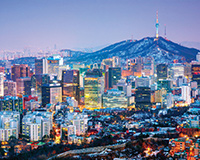The retail streetscapes of Korea make a refreshing change from shopping centre-dominated China.
It looks as though 2014 has, so far, been the year that Seoul finally put the financial crisis behind it as there are signs of development activity once more.
The Korean capital’s retail scene has historically been dominated by street shops and major department stores. But over the past decade shopping centres have emerged as a strong element in the market and are popular with consumers.
There are a limited number of shopping centres currently in existence – just 10 in the city providing some 13m sq ft of space – most of which perform well. Some even exceed $1bn (£600,000) in annual sales. Almost all of the centres have zero vacancy and performance is considered strong, with capitalisation rates for prime retail space in the range of 5%-6%.
As a result, we are seeing developers such as Kyung Pang, the group behind the successful Times Square project in central Seoul, investing time into repositioning existing assets. Companies are increasingly looking to convert office space to retail to feed demand as the capital city continues to attract huge numbers of Chinese tourists.
Retail investment, dominated by the Korean conglomerates Shinsegae, Lotte and Hyundai and international investors Invesco, GIC, Angelo Gordon, and Taubman, has also started to realign to fit with the changing market. Historically these investors have focused on department store development, but some of their recent projects are hybrids with some shopping centre features.
And it’s not just the capital’s retail offering making Korea an attractive proposition. The rise of Korea’s lower-tier cities is also seducing retailers entering the market. Increasingly they can expect good returns outside of Seoul by going deeper into the country with more stores. Property developers are reacting to this trend and, with the promise of strong retailer demand, they are now more confident about investing in retail in smaller cities.
So where exactly are they targeting? Just a 45-minute flight south lies Busan, a relaxed seaside town and Korea’s second city. Its key city centre districts of Seomyeon and Gwangbok Dong are increasingly attracting the attention of international retailers including Nike, Adidas and Uniqlo as, like Seoul, it is proving attractive as a holiday destination for Chinese tourists.
Korea’s mighty department store chain Shinsegae has a strong presence in Busan. Its 12.6m sq ft outlet at Centum City in the Haeundae area is billed as the largest in the world, and ranks in Korea’s top five department stores for sales turnover.
Ulsan, just an hour’s drive from Busan, is deeper into tier-two Korea. The existing Hyundai department store is in the top 30 nationwide. A short walk away lies UP Square, Ulsan’s first shopping centre development, which opened last year with brands including Uniqlo and H&M.
International retailers have in the past been particularly focused on the scale offered by China or the maturity of Japan when charting their initial moves towards Asia. But Korea offers an interesting mix of maturity and scale and shouldn’t be ignored.
James Hawkey is managing director, retail, Hong Kong and China, at Cushman & Wakefield











